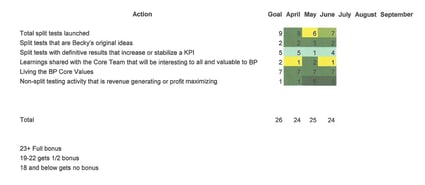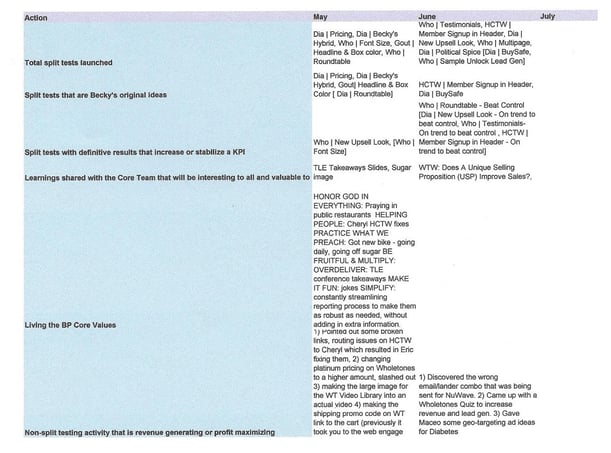Many companies and managers believe a dashboard is a great way to keep their staff focused on the metrics and priority that they should be targeting for quarterly and weekly objectives.
When and how do you do this effectively?
Barton Publishing’s chief marketing director Marty Fahncke shared his example of how he quickly boost a new employee’s clarity on accountabilities. Just as importantly he is receiving consistent performance reports from her without having to over supervise the position.
The first step in Rockefeller Habits 4-3-2-1 formula for driving growth in a business, once the 3-5 year plan, annual plan and quarterly plans are documented is Execution.
The most common reason businesses’ fail is due poor decision-making. Most often this is a lack of time invested in proper strategic planning. Usually the main reason the leader and the executive team has little or no time to strategically work on the business is because the company is not executing properly. The leader and the executive team are constantly being pulled into the operations of the business to manage, intervene, solve issues and often work tactically in the business.
In order to have time to strategically focus on your business you need to have the proper resources and tools in place to allow to you monitor, affect and have confidence in your business’ execution.
That’s why Positioning Systems Strategic Discipline’s is critical. Strategic Discipline focuses on:
- Priorities
- Meeting Rhythms
- Metrics
Marty’s focus was on the priorities and metrics. When a new employee starts, onboarding is critical to long term engagement and tenure. A good tool to use to determine an employee’s priorities and accountabilities is Topgrading’s Job Summary Scorecard. It should be used to judge the candidates qualification for the position when you interviewed them. If so, they’re already aware of their accountabilities when they start.
 Looking at Marty’s employee’s dashboard you can see five actions defined for this candidate to achieve a bonus each month. An additional Action is living Barton Publishing’s Core Values. You can see by this person’s progress so far they’ve earned their full bonus each month since starting in April.
Looking at Marty’s employee’s dashboard you can see five actions defined for this candidate to achieve a bonus each month. An additional Action is living Barton Publishing’s Core Values. You can see by this person’s progress so far they’ve earned their full bonus each month since starting in April.
If you understand and apply the principle of Pearson’s Law it’s not difficult to understand why measuring and reporting back leads to achievement.
Marty employee created a second page to put in the actual actions she’d completed. It may be a little more difficult to read this since I had to shrink it to fit as a picture into this blog.  On this second page the employee briefly describes what she did to meet the objectives. The beauty of this for Marty is he can look at his employee’s second sheet on her dashboard and get details on what she is doing to hit her targets.
On this second page the employee briefly describes what she did to meet the objectives. The beauty of this for Marty is he can look at his employee’s second sheet on her dashboard and get details on what she is doing to hit her targets.
One of my favorite books is Ralph C. Stayer & James Belasco, Flight of the Buffalo. Ralph was the CEO at Johnsonville Sausage Company in when I visited him in Sheboygan, Wisconsin shortly after Tom Peters featured his company in his book In Search of Excellence. His quote on empowering people has stuck with me ever since he shared time with me in his office in 1995:
“Do the people in your company know how well they’ve done before they go home every night? People perform what they measure – help the performers to measure the “right” stuff.
I’ll bet Marty’s new employee knows each night when she’s finished how well she did to achieve her positions function. Imagine if every one of your employees could acknowledge their contribution to the company each evening. There’s a tremendous source of pride in what you do when you can recognize your achievements!
So many times we place blame on the people who work for us and with us for not achieving their objectives. How many times is it due to our failure as managers and leaders to accurately provide them with clarity on their accountabilities including their highest priorities?
Effective one-on-one coaching, a clear job summary scorecard (or job description), recognition and support for achievement, these are your tools and resources to earn the respect and high performance of the people you lead and manage.
Give your people clarity on their job function. Ask them to build a dashboard that accurately assess their performance against these accountabilities and then monitor their progress. Get it right and you will have a team doing the right stuff right consistently.
What’s the multiplier of human potential? You may have heard the expression, “A little child shall lead them.” I’ll be sharing my granddaughters short commencement address from preschool and the key to human potential next blog.






.jpeg?width=150&height=135&name=Hand%20with%20marker%20writing%20the%20question%20Whats%20Next_%20(1).jpeg)

